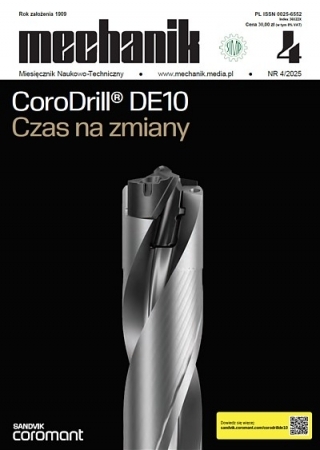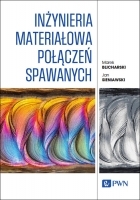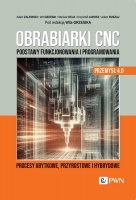Stanowisko do pomiaru objętości półfabrykatu za pomocą czujnika laserowego *
Stand for measuring the volume of the blank using a laser sensor
Mechanik nr 11/2018 - Metrologia techniczna
STRESZCZENIE: Przedstawiono stanowisko i metodę pomiaru objętości półfabrykatu za pomocą czujnika laserowego. W analizowanym fragmencie procesu wytwarzania armatury wodnej półfabrykat w postaci mosiężnego pręta jest cięty na pile poprzecznej na wstępniaki o określonej masie. Ze względu na stosowaną bezwypływkową technologię kucia wymagana jest duża dokładność ucinanych wstępniaków, rozumiana jako względna tolerancja masy poniżej 0,1%. W takiej sytuacji istotny jest pomiar geometrii pręta, umożliwiający obliczenie jego objętości i ustawienie na tej podstawie miejsca cięcia. Naturalnym sposobem obliczania objętości brył obrotowych o skomplikowanych kształtach jest wyznaczenie w zadanych granicach wartości całki oznaczonej krzywej, opisującej zewnętrzną powierzchnię bryły obracającej się dookoła pewnej osi. Jednakże w przypadku brył obarczonych błędem geometrii ściany bocznej, który może się zmieniać w zależności od wysokości, ta funkcja może się zmieniać wraz z kątem obrotu tej bryły. W przypadku układów rzeczywistych, gdy wyniki pomiarów stanowią dyskretny ciąg liczb, naturalnym sposobem jest całkowanie numeryczne. Gdy poprawnie dobierze się dokładność pomiarową czujnika oraz podzieli całą bryłę na odpowiednio małe fragmenty, błąd wynikający z numerycznego rozwiązania zagadnienia jest pomijalny, a proces obliczeniowy – szybki, co pozwala na zastosowanie komputera przemysłowego klasy ekonomicznej. W artykule przedstawiono zastosowanie czujnika laserowego – przesuwanego wokół osi oraz wzdłuż pręta i służącego do pomiaru jego objętości – a także koncepcję kompletnego stanowiska pomiarowego.
SŁOWA KLUCZOWE: pomiar objętości, czujnik laserowy
ABSTRACT: The aim of the article is to present a method of measuring the volume of a blank using a laser sensor and a complete measuring stand. In the analyzed part of the manufacturing process of water fittings, the brass rod is cut on blanks of a given weight using CNC sawing machine. Due to the applied flashless forging technology, high cutting precision is required, understood as a relative mass tolerance of the blank of less than 0.1%. In this case, it becomes important to measure the geometry of the rod to calculate its volume – to correct the length of the blank. The natural way to calculate the volume of rotational solids with complex shapes is to determine the definite integral of the curve describing the outer surface of the solid. However, in the case of solids with geometrical errors this function may vary with the angle of rotation of the solid. In the case of real systems, in which the measurement results are a discrete sequence of numbers, it is natural to choose numerical integration. The paper presents the use of a laser sensor moved around the axis and along the rod to measure its volume and the concept of a complete measuring stand.
KEYWORDS: volume measurement, laser sensor
BIBLIOGRAFIA / BIBLIOGRAPHY:
- Kuramoto N., Fujii K., Yamazawa K. “Volume measurements of 28Si spheres using an interferometer with a flat etalon to determine the Avogadro constant”. Metrologia. 48, 2, s. 83–95.
- Bhat S.S., Smith J. “Laser and sound scanner for non-contact 3D volume measurement and surface texture analysis”. Physiological Measurement. 15, 1, s. 79.
- Marjanovic D., Dugdale R.E., Vowden P., Vowden K.R. “Measurement of the volume of a leg ulcer using a laser scanner”. Physiological Measurement. 19, 4, s. 535–543.
- Gardner W.B., Cameron R.G., Vowden P., Lane C., Grocott P. “A technique for the use of 3D surface imaging to study wound dressing fixation”. Wounds. 17, 12, s. 337–346.
- Jabłoński R., Mąkowski J. “Measurement of cylinder diameter by laser scanning”. Recent Advances in Mechatronics (red.: R. Jabłoński, M. Turkowski, R. Szewczyk). Berlin, Heidelberg: Springer.
- EN ISO 14253-1:1998 Geometrical Product Specifications (GPS) – Inspection by measurement of workpieces and measuring equipment – Part I. Decision rules for proving conformance or non-conformance with specifications.
- Chen Y., Liu C. “Radius and orientation measurement for cylindrical objects by a light section sensor”. Sensors. 16, 11, s. E1981.
- Fedorov E., Koba A. “Diameter Calculation in Contactless Three-Axis Measuring Devices”. MATEC Web Conf. 79 01082.
- https://bhkarcz.pl/mitutoyo (dostęp: 07.05.2018 r.).
- www.ultrakraft.ru (dostęp: 07.05.2018 r.).
- www.ita-polska.com.pl (dostęp: 07.05.2018 r.).
DOI: https://doi.org/10.17814/mechanik.2018.11.179
* Artykuł recenzowany





















